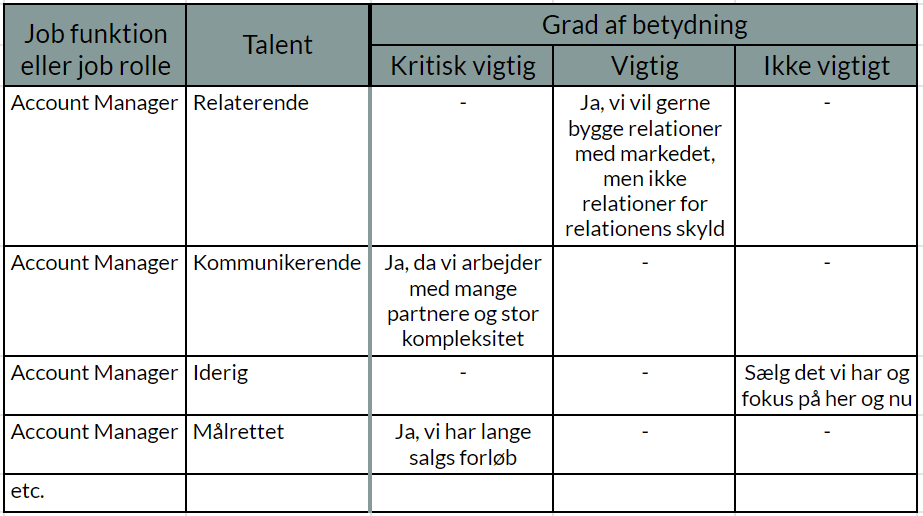5 tips to securely getting started with talent development
When it comes to getting the most out of the human resources that a company has, then talent development is one of the most effective methods. But it can be difficult getting started. How do you avoid the classic mistakes and secure that development doesn’t only happen at courses once a quarter? In the guide we share our experience and 5 stepping stones, so that you can get started and ge tthe wind in your back from both the employees and the top leaders.
By Per Bergfors
Per has 20 years of experience within management, sales and marketing in companies. Also works as Assistant Professor at CBS, and therefore has solid experience as talent developer, teacher and communicator.
divide
Guide to talent development
Reading time 6 min.
It is important that we think diversity into talent, so that we do not overlook the individual employees personal talent and lose the valuable resources. Everyone has a special potential within a certain field – everyone has a talent.
Talents are unfolded, if they are challenged and placed in the relevant link. Therefore the work place needs to prioritize the talents that are relevant for the tasks that needs to be solved. Not all employees are naturally motivated to sarch for development of competencies and talents themselves. This is why you need to help them on their way.
It is definitely a leadership task, to secure that the relevant talents are unfolded and activated. Development means that you should make more out of what you are already doing. That of course requires action from you as a leader and the leadership style that you use. It also requires a certain buy-in from the company. But if you reach success with developing your own and other’s talents, then it becomes a strength and thereby an actual value for the person and the organization.
At TalentInsights we have developed a framework that secures a structured and holistic approach to talent development. We call our framework the talent developments 5 stepping stones.
- Who: Everyone in the organization has talent
- Why: secure satisfaction so that everyone uses their talent
- What: The leadership style so that the talent works with what is the most relevant
- How: Through assignments that the talent spots and executes
- When: In daily life, the talent is used on the concrete assignment being developed and fine-tuned.
1/ Who: What talents are needed where?
One thing is for sure when you start with talent development – and that is the fact that everyone has talent. Therefore it is also imprtant that the relevant talent is spotted and uncovered.
The individual employees talents are prioritized after which are strategically, tactically or operationally important for the business. When it comes to the strategic approach, then it is a good idea to first create an overview over the 34 talents. Think of the organizations strategy, and then mark the talents one to one in relation to whether the talent is critically important, important, or not important for the specific job function or job role at hand.
We have met companies, that find it easy to start on the strategic level and think what talent mass is needed, while others start with looking at important job functions, and then judging what talent is critical. Both approaches work, so choose what fits best for you. You can use this template if you’re on the basis of job functions:

If you are having a hard time understanding what talents need to be interpreted, then here is an example:
The communicating talent gives results for example in the fact that some people have the ability to spell bind others through their way of talking and convey messages. As account manager with many internal and external contact surfaces, it will be crucial for success that you can make yourself understandable towards different target groups.
When you need to create an overview over the talent mass, then it’s important to connect the talents so that they create as much value as possible for companies, as well as the individual employee being motivated. In order for both to be fulfilled, the individual employee’s talents are uncovered TalentIndikator©via a talent test, in order for you to get insight into what your top talents are. It is exactly when the individuals’ top talents are put into play that the employee achieves satisfaction and motivation.
2/ Why: Secure satisfaction so that everyone uses their talent
You can easily see on your employees whether they are satisfied. They smile, trade information, help each other, have something to do, speak with each other and are curious.
Satisfaction is a result of the employees completing the activities that match their talents. When there is a match between talents and work assignments, you create a great value for the organization.
Satisfaction is a result of contributing, as well as a prerequisite for creating collective development. The better the development environment is fitted to the match between tasks and talent, the greater the chance is that you develop a talent environment.
To secure that you create a satisfactory environment, you can discuss in the leadership group how you show trust, so that employees want to and are willing to take on new challenges. Is there space to search for relevant knowledge? Is there space to share experiences? Is there a possibility for experimenting? When you can say yes to all of these questions, then the framework is in place
3/ What: The leadership style so that the talent works with the most relevant
The leadership style tells you whether there is space for development or whether all focus is on delivering and producing. Here are some of the ways you can create an environment that can deal with change and development:
- Make it legitimate to use 20% of working hours on developing the job function and make sure it is talked about.
- Are we leading the talent in a relevant way with a balance of inspiration, coaching and leadership?
- When we are working in projects or teams, is there enough freedom to choose measures and tools?
- The employee that is closest to the problem needs space to choose models for solving it.
- The team should be developed through the individual team members use of their respective talents.
READ: The blog ”4 aspects of leadership” for a deeper perspective on the leadership task.
4/ How: Through assignments that the talent spots and completes itself
The employee should have the possibility to demonstrate their talent in order to be satisfied and feel that they are contributing with relevant knowledge and behaviour. To use the communicative talent again, so it’s not beneficial if the communicative talent doesn’t have the opportunity to share their results with other people. Mediation and dialogue for the communicative talent should be a part of the employees daily work. It is our experience that “tasks go towards where tasks are solved”.
The employee that is aware of their talent wants space to unfold so that the talent effort gives possibility for immersion and reflection. “Where can i use it even more?” is what the employee could think. Talents are different and talents should be developed differently. It is important to do away with the equality culture, by leading everyone differently for better development opportunities. It is about giving more meaning to the individual – you can look for inspiration here. [hvordan finder jeg mening].
It can be a good idea to think of tasks as stepping stones in different career paths. We often meet 4 career paths; the leadership/partner road, salesperson/customer, the specialist that immerses themselves as well as project leadership.
5/ When: In daily life, when the talent is used on the concrete task, it is developed and fine-tuned.
Different talents see the same assignment through different glasses. Therefor it is alpha omega that you see and unfold the different talents, by giving space for discussions and alternative angles in the daily leadership. A big advantage of this approach is that the development aspect is removed from an ad hoc assignment, something you put to the side and only do when you are at a course, into a continual flow that is part of your leadership strategy. In this way you create a development environment that is focused on improvements, instead of changes.
We often see that the attitude of yourself is reflected in the organization, in the form of the amount of will and engagement. The five stepping stones makes it possible to focus on talent development and creating an environment for talent development where there is space for everyone.
It is very difficult to compensate missing talent within an area, with increased subject knowledge. On the other hand you can get more output from the given subject knowledge, by giving space for the talent to unfold itself and it is for that reason that talent development is the future for the modern company.
divide
Maybe these blogs are something for you?

How do I find more meaning?
Here you can become inspired to finding purpose and meaning through knowledge about your exact talents.

Can you afford to exclude talented organizational development?
Can you afford to exclude talented organizational development? You can probably rightly claim that organizational development has existed ever since humans started organizing themselves in

Speed up your innovation through talents in your organization.
[Talents that drive innovation A blog for you who wishes to understand what kind of synergy occurs when you are thinking of innovation through the


